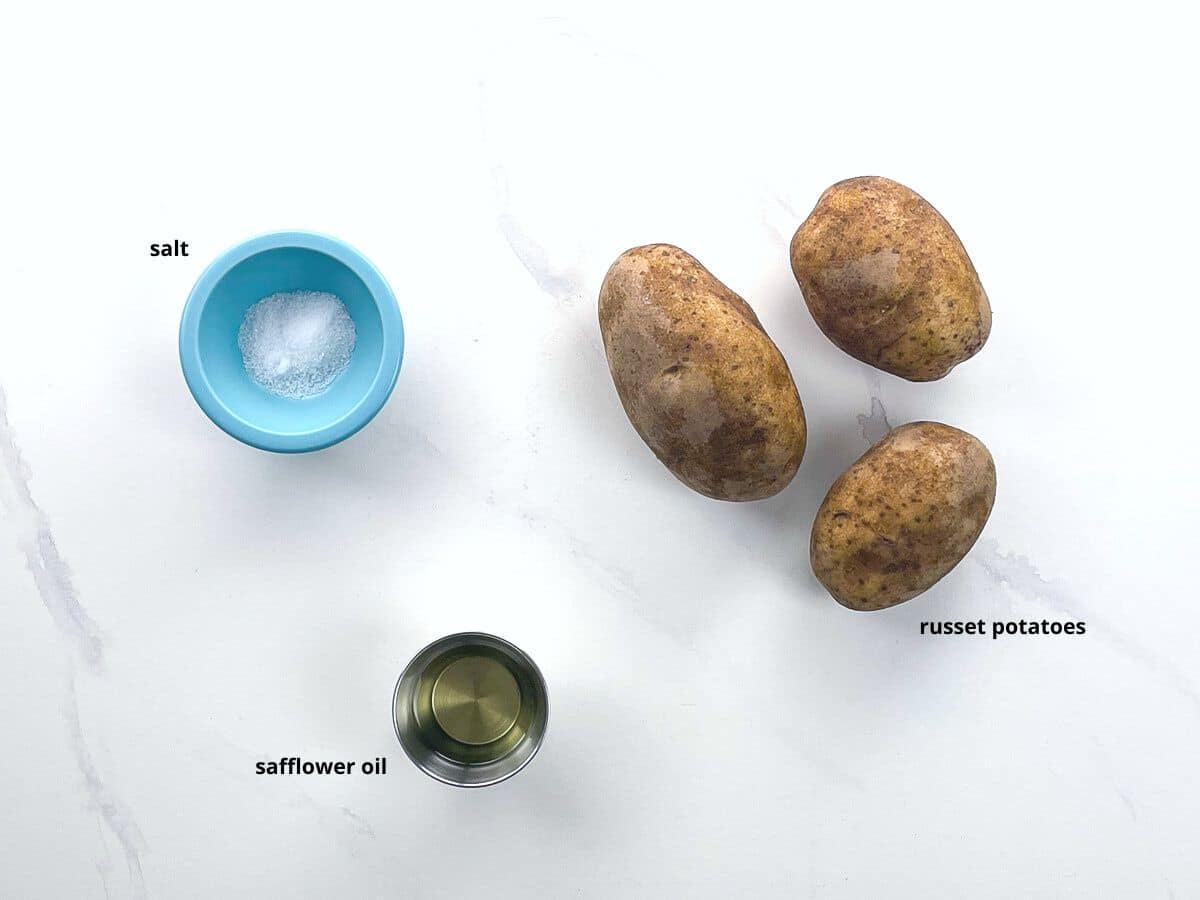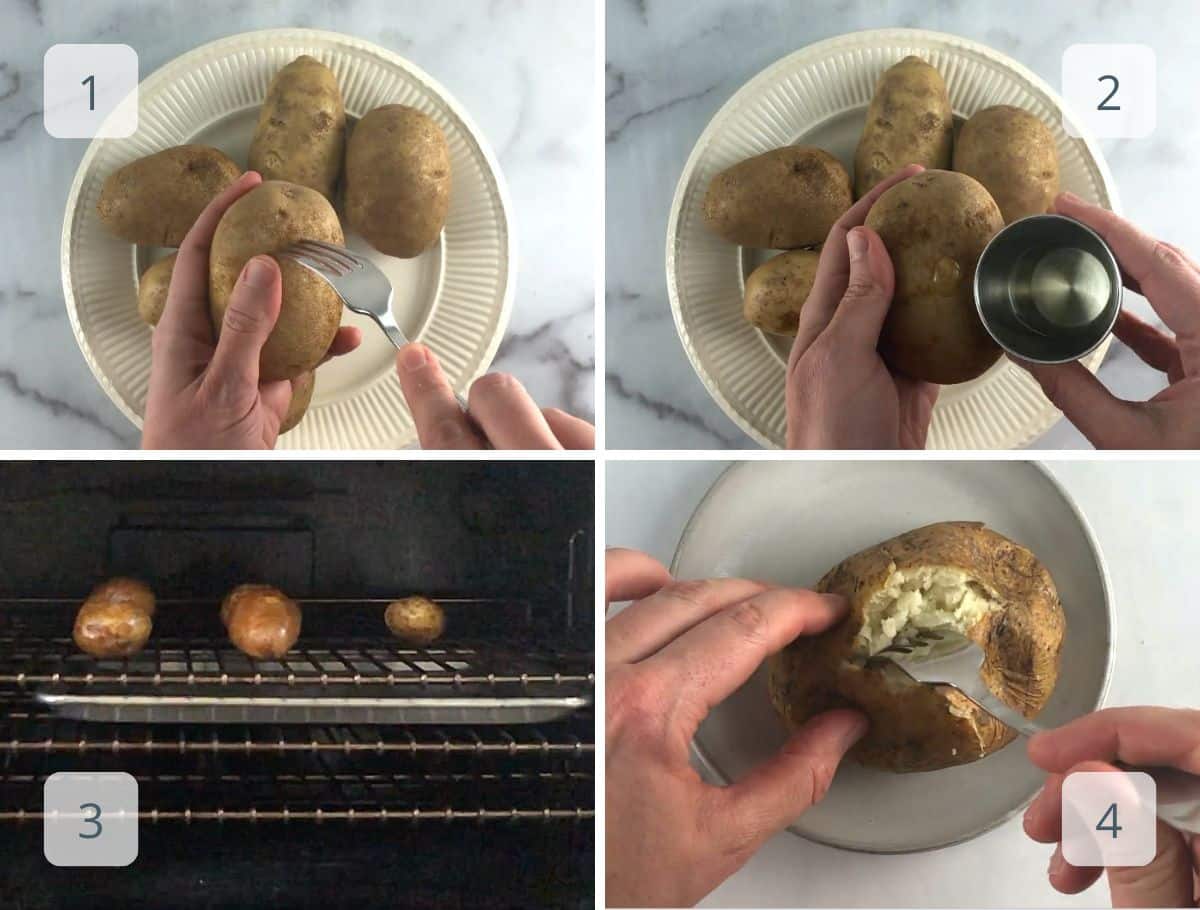From classic side dish for steak to complete vegan meal, there's no food more flexible than the baked potato. Here's everything you need to know to make it great, no matter the circumstances.

Why we love this recipe
I really believe that your baked potato should be both perfect and 100% fuss-free every single time. The good news is that with a few simple tips, it's easy to achieve that goal.
In this post I'll show you how to:
- Choose the best potatoes for the job
- Decide between the oven-only, microwave and oven, or toaster oven method
- Prep your spuds for baking
- Bake them to crisp-outside, fluffy inside perfection, without any mess
- Top them simply or elaborately
- Use your leftovers creatively
What you'll need
Here's a glance at the ingredients you'll need to make this recipe.

- Russet or Idaho potatoes are starchy varieties, and that's what you want for this recipe. Starchy potatoes will give you the crisp outsides and fluffy, tender insides that make great baked potatoes. Potatoes are often part of the "dirty dozen," meaning conventionally grown potatoes tend to have a very high pesticide concentration. Since you don't peel baked potatoes, it's a good idea to buy organic potatoes if you can.
- Safflower oil is my high-smoke-point, neutral-tasting vegetable oil of choice. You can substitute another oil that has similar properties, such as canola, sunflower, peanut, corn, or vegetable oil blend.
- Fine sea salt is my go-to for most purposes, including this one. It tastes great and is small enough to distribute well.
How to make it
Here's an overview of what you'll do to make fabulous baked potatoes. You can see the steps in action in the video that accompanies this post, and get all the details in the recipe card below.

Oven method
This is my favorite method when I'm cooking quite a few potatoes and I have plenty of time.
- Preheat oven to 400°F (or see chart below for other oven temperature and time combos. Place a rack in the center of the oven (this is where your potatoes will go) and a rack at the bottom with a rimmed baking sheet (lined with foil or parchment if you like, for easier cleanup) to catch any drips. Baking potatoes straight on the oven rack is the best way to ensure crisp skin and even cooking all around. Scrub potatoes clean and dry them well. Poke shallow holes all around each potato with the tines of a fork to let some steam escape during baking.
- Rub each potato with a little bit of oil and sprinkle with salt. This helps crisp the skins, makes salt stick easily, and "magically" (i.e. scientifically) regulate the moisture inside the potatoes as the cook.
- Place potatoes directly onto middle oven rack and bake until very tender throughout. Baking time will vary with the size of your potatoes, but should be around an hour for medium-sized potatoes.
- Potatoes are done when they yield easily to a fork or give readily when you squeeze them.
Quick baked potato: microwave and oven method
If you're short on time and making one to four potatoes, starting baked potatoes in the microwave is a useful hack.
- Preheat oven to 450°F. Place a rack in the center and a rack at the bottom with a rimmed baking sheet (lined with foil or parchment if you like, for easier cleanup) to catch any drips. Scrub potatoes clean and dry them well. Poke shallow holes all around each potato with the tines of a fork to let some steam escape during cooking.
- Place potatoes in microwave. For 1-2 potatoes, cook on high for 6 minutes. For 3-4 potatoes, cook on high for 12 minutes. Carefully rub each hot potato with a little bit of oil and sprinkle with salt.
- Place potatoes directly onto middle oven rack and back until crisp outside and very tender inside, about 20 minutes depending on size.
- Potatoes are done when they yield easily to a fork or give readily when you squeeze them.
Baked potato in the toaster oven
If you'd rather not crank up the regular oven and you're only making a few potatoes, you can use the toaster oven to replicate either of the methods above. Follow the steps, temperature, and timing for either the oven method or the microwave and oven method above, but use your toaster oven instead of the full-size one.
If your toaster oven only has one rack and there's no way to catch drips, I don't recommend baking the potatoes directly on the rack. Depending on the configuration of your appliance, the best bet is usually to position the rack lower in the toaster oven and place the potatoes onto the two-piece broiler pan.
Time and temperature chart
If you've got free reign over your oven, I recommend 400°F for nice crisp skins (or 450°F if you're starting the potatoes in the microwave). But it's also totally fine to bake potatoes alongside another dish, in which case you may not have any flexibility with the temperature.
How long to bake a potato depends on both oven temperature and potato size. Here's a general guideline for medium-sized russet potatoes based on oven temperature. It's better to cook your potatoes slightly longer than slightly too short. Potatoes are hard to overcook terribly, and no one wants a crunchy center.
| Oven temperature | Baking time |
| 325°F | 90-120 minutes |
| 350°F | 75-105 minutes |
| 375°F | 70-100 minutes |
| 400°F | 60-90 minutes |
| 425°F | 45-75 minutes |
Baked potato topping ideas
The sky's the limit here, my friend. For a classic side dish, a generous amount of good cultured, salted butter or sour cream, a sprinkle of flaky sea salt and freshly ground black pepper, and some minced chives add up to sheer, simple perfection.
To make a potato into a main course, try one of these toppers, just to name a few:
- Vegetarian chili and shredded cheddar
- Hummus and chopped red bell peppers
- BBQ pulled chicken
- Nacho-style toppings (black or pinto beans, guac, sour cream, crumbled cotija cheese and cilantro sauce or jarred salsa)
- Classic tuna salad (trust me, it works!)
Expert tips and FAQs
Absolutely, and that's what I prefer to do. A baked potato in foil is actually steamed, since the foil retains and circulates the moisture throughout cooking. That's fine, especially if you don't want to eat the skin. But baking without foil is the best way to get nice, flavorful, crispy skin while retaining a tender, fluffy interior.
Yes, and it's the best way to ensure nice, even crisping and cooking. Even though you'll only use a tiny bit of oil on each potato, you'll want to place a pan on a lower rack to catch any drips and prevent smoking.
Baked potatoes are so hands-off that I usually make them shortly before serving. But if you want to make a bigger batch ahead of time, or you end up with leftovers, it's fine to reheat them, either in the oven or the microwave.
You can pop them into the oven at virtually any temperature and pull them out when heated through. When reheating in the microwave, I like to cut them in half first and mash up the interiors a little bit with a fork so them reheat more evenly.
If you'd like to use leftovers in a different way, see the section below for my favorite suggestions.
Leftover baked potato recipes
Feel like remixing your leftovers? Here are my favorite ways to use them:

Hungry for more?
Subscribe to Umami Girl's email updates, and follow along on Instagram.

Perfect Baked Potatoes (Oven or Microwave and Oven)
Ingredients
- 6 russet potatoes (also called Idaho potatoes)
- 1 tablespoon safflower oil
- Fine sea salt
Instructions
Oven method (preferred)
- Preheat oven to 400°F. Place a rack in the center and a rack at the bottom with a rimmed baking sheet (lined with foil or parchment if you like, for easier cleanup) to catch any drips.
- Scrub potatoes clean and dry them well. Poke shallow holes all around each potato with the tines of a fork to let some steam escape during baking.
- Rub each potato with a little bit of oil and sprinkle with salt.
- Place potatoes directly onto middle oven rack and bake until very tender throughout. Baking time will vary with the size of your potatoes, but should be around an hour for medium-sized potatoes.
- Potatoes are done when they yield easily to a fork or give readily when you squeeze them.
Microwave + oven method (quicker, best for 1 to 4 potatoes)
- Preheat oven to 450°F. Place a rack in the center and a rack at the bottom with a rimmed baking sheet (lined with foil or parchment if you like, for easier cleanup) to catch any drips.
- Scrub potatoes clean and dry them well. Poke shallow holes all around each potato with the tines of a fork to let some steam escape during cooking.
- Place potatoes in microwave. For 1-2 potatoes, cook on high for 6 minutes. For 3-4 potatoes, cook on high for 12 minutes.
- Carefully rub each hot potato with a little bit of oil and sprinkle with salt.
- Place potatoes directly onto middle oven rack and back until crisp outside and very tender inside, about 20 minutes depending on size.
- Potatoes are done when they yield easily to a fork or give readily when you squeeze them.
To serve baked potatoes
- Cut a slit lengthwise across the middle ⅔ of each potato. Squeeze potato in and up from both ends. Top with butter or sour cream, chopped chives, and a sprinkle of flaky sea salt — or whatever you like. The sky's the limit.
Video
Notes
- Russet or Idaho potatoes are starchy varieties, and that's what you want for this recipe. Starchy potatoes will give you the crisp outsides and fluffy, tender insides that make great baked potatoes. Potatoes are often part of the "dirty dozen," meaning conventionally grown potatoes tend to have a very high pesticide concentration. Since you don't peel baked potatoes, it's a good idea to buy organic potatoes if you can.
- Safflower oil is my high-smoke-point, neutral-tasting vegetable oil of choice. You can substitute another oil that has similar properties, such as canola, sunflower, peanut, corn, or vegetable oil blend.
- Fine sea salt is my go-to for most purposes, including this one. It tastes great and is small enough to distribute well.
- Baked potatoes are so hands-off that I usually make them shortly before serving. But if you want to make a bigger batch ahead of time, or you end up with leftovers, it's fine to reheat them, either in the oven or the microwave. You can pop them into the oven at virtually any temperature and pull them out when heated through. When reheating in the microwave, I like to cut them in half first and mash up the interiors a little bit with a fork so them reheat more evenly.
Nutrition
Hungry for more?
Subscribe to Umami Girl's email updates, and follow along on Instagram.








Leave a Reply